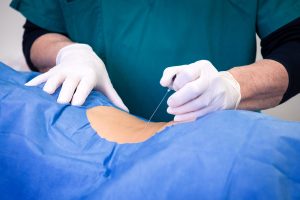
Johns Hopkins researchers—including research professor Peter Kazanzides and John C. Malone Professor of Computer Science Russell Taylor; PhD students Baichuan Jiang and Keshuai Xu; alumnus Liam Wang, Engr ’23; and principal investigator Emad Boctor, a department affiliate and the director of the Medical UltraSound Imaging and Intervention Collaboration Research Laboratory—are partnering with Clear Guide Medical, a Baltimore-based imaging device company, to develop a new wearable, ultrasound-based augmented reality navigation system that shows promise in increasing the accuracy and effectiveness of lumbar puncture procedures.
A lumbar puncture—or “spinal tap”—is a common clinical procedure in which a hollow needle is used to penetrate the spinal canal to access the fluid surrounding the brain and spinal cord. This fluid can be used to diagnose various conditions and diseases related to the nervous system. Lumbar punctures are also sometimes necessary to inject anesthetics or chemotherapy treatment.
But to insert the needle in the right location, physicians have to use their hands to feel the gap between two lumbar bones, which can be challenging with obese or elderly patients. Repeated attempts to make a successful puncture can be painful for the patient and may lead to contamination of the cerebrospinal fluid, potentially causing life-threatening complications.
The researchers’ proposed navigation system will supplement this process with real-time ultrasound guidance and needle insertion planning so that physicians will only have to insert the needle once. The results of their preclinical study were recently published in IEEE Transactions on Medical Robotics and Bionics.
Read more about this innovation here.